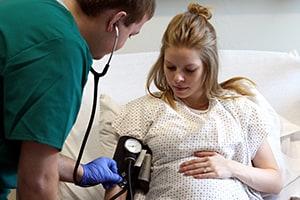Help Center
Online Resource Center for Information on Birth Injuries.

Blood clots are a serious medical condition that can have fatal side effects if left untreated, and if one develops during your pregnancy it could put both you and your baby at risk. Expecting mothers are at an increased risk of blood clots, especially for older women and those expecting multiples. Fortunately, blood clots are preventable and there are several steps women can take to help reduce the risk. However, if you start experiencing any symptoms that could be linked to a blood clot, make an appointment with your doctor immediately to prevent further complications.
Blood clotting is usually a good thing. When the skin is broken and starts to bleed, the blood naturally clots to close to the wound and stop the bleeding. Blood clotting becomes problematic, however, when a clot develops inside deep veins located throughout the body. This is known as deep vein thrombosis (DVT). For most women in pregnancy, these type of clots usually occur in the leg or pelvic region.
The life cycle of a blood clot begins with the platelets that move throughout the veins. Clotting of the blood occurs when these platelets begin to accumulate together in a specific area. When a blood vessel is damaged in some way, the platelets are triggered to go and repair that area. The platelets begin to stick to the walls inside the vein eventually forming a type of plug. The platelets then send out messages for other cells to come help, creating a chain reaction of cell build-up, rapidly forming the clot.
In most cases, the body eventually breaks down the blood clot and there are no complications. During pregnancy, there is an increased risk of the blood clot growing too large and breaking off into the bloodstream. When the clot breaks off, it can travel to the lungs and block the stream of blood flowing through them. This is known as pulmonary embolism (PE) and can be deadly. PE is one of the most common causes of pregnancy-related death in the United States.
Blood clots can also form in the baby’s placenta. This usually occurs in women who already have an increased risk of developing one. A blood clot in the placenta can block blood being supplied to the baby, which can result in a miscarriage or stillbirth.
Pregnant women are more at risk for getting blood clots for several different reasons. During pregnancy, a woman’s blood clots more rapidly in preparation to lessen the amount of blood loss during labor and delivery. As the baby grows, it puts more and more pressure on the woman’s pelvis, which reduces the amount of blood flow to the legs. This combination of more rapid clotting and reduced blood circulation makes blood clotting in the lower body a real danger during pregnancy.
Other risk factors that could increase your chance of blood clots include:
It’s important to be able to recognize the symptoms of blood clots. If the blood clot is addressed early on, it can be successfully treated with certain medications. If you experience symptoms of DVT, immediately make an appointment to see your doctor to prevent further complications.
Symptoms of DVT include:
PE is a much more serious condition that requires urgent treatment. If you start experiencing PE symptoms, treat the symptoms seriously and go to the nearest emergency room.
Symptoms of PE include:
Besides pulmonary embolism, there are other risks associated with blood clots, including:
The good news is that blood clots are highly preventable with the right precautions. One of the most crucial factors in preventing blood clots is to maintain a healthy lifestyle and stay active throughout your pregnancy. Light exercise is recommended to improve circulation but every woman’s pregnancy is unique, so ask your doctor about the best way to stay mobile. Avoid smoking and being around secondhand smoke as it has been proven to increase the risk of blood clots. Keeping a healthy diet can prevent clogging of the arteries, which can make it easier for cells to build up in the veins.
If you’re traveling while pregnant and intend to stay immobile for more than four hours, make sure to move your legs frequently and exercise the calf muscles. If possible, take a walk every hour or so to keep blood flowing. You can also do seated leg stretches by extending the legs straight out, rotating the ankles and feet, and then pulling the knee towards the chest for 10-15 seconds. Repeat this exercise 15 times if you’re going to be seated for an extended period.
Blood clots are treated with anticoagulants, which are safe to take during pregnancy. Anticoagulants help to break up blood clots and prevent them from occurring again.
James, A. H. (2017). Pregnancy, contraception and venous thromboembolism (deep vein thrombosis and pulmonary embolism). Vascular Medicine, 22(2), 166-169.
PR Newswire. (2013, April 2). Stillbirth or Pre-Term Birth Outcomes Linked to Elevated Risk of Blood Clots After Pregnancy. PR Newswire US.
Steven K. Galson. (2008). Prevention of Deep Vein Thrombosis and Pulmonary Embolism. Public Health Reports. 123(4), 420.
Mikhail M. Vinokurov, Anton A. Yakovlev, Vasily P. Ignatiev, Natalia I. Douglas, Gennady A. Palshin, Iana G. Rad, & Innokenty D. Ushnitsky. (2018). Treatment of Acute Venous Thromboses and Pulmonary Embolism during Pregnancy. International Journal of Biomedicine, (3), 244.
Chan, W.-S. (2018). Diagnosis of venous thromboembolism in pregnancy. Thrombosis Research, 163, 221-228.
Lim, A., Samarage, A., & Lim, B. H. (2016). Venous thromboembolism in pregnancy. Obstetrics, Gynaecology & Reproductive Medicine, 26(5), 133-139.